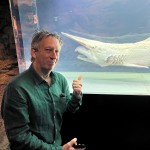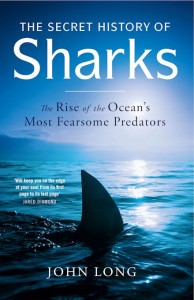Welcome to the ANZAAS Website
Almost every aspect of our life is touched by science. Without science our way of life would be almost unimaginable and sustainability of life in the future will be impossible. Despite this there is great public suspicion of science. Much of this is based on lack of understanding, but past failures of science to recognise public concerns about the nature and direction of progress contribute to distrust. The future is too important for such attitudes to continue. ANZAAS exists to promote dialogue and understanding between the public, science and government and to advance science and its utilisation for maximum benefit.
next ANZAAS Science Talk, Melbourne
Wednesday 21st May 2025, 6:30 pm
At Bio21 Institute, 30 Flemington Rd, near corner with Park Drive, Parkville
Professor John A. Long
Strategic Professor in Palaeontology, Flinders University
“The Secret History of Sharks – Lessons in Evolution and Survival”
 Chondrichthyans, the group inclusive of sharks, rays, chimaerids and various extinct groups, have been around for at least 465 million years, based on records of scales from central Australia. The first 50 million years of the chondrichthyan fossil record is poorly represented, but more complete ‘sharks’ start to appear in the Devonian period, when they acquired the ability to replace their teeth regularly. Early research into them using CT scanning and detailed histological investigations is making breakthroughs about their early evolution. Gogoselachus, a shark from the Devonian of Western Australia, showed that some early sharks had bone cells present within the cartilage skeleton. While cartilage skeletons do not preserve as well as bone, exceptional fossil sites show complete shark remains throughout the geological record, some with soft tissue and stomach remains preserved. These fossils allow us to infer their behaviour and lifestyles and give insights into how they might have survived all five major global mass extinction events. Chondrichthyans reached peak of diversity relative to other fish groups in the Early Carboniferous period, when they outnumbered bony fishes in several major faunas. During the end of the Palaeozoic gigantic, specialised forms like the 10m long Helicoprion, with buzz-saw shaped tooth-whorls, fed primarily on cephalopods. During the age of dinosaurs, sharks had to contend with huge marine reptiles competing for resources and were mostly very small species for about140 million years. Sharks emerged as major predators by the end of the Cretaceous, and during their last 66 million years, evolved into some of the largest predators of all time, including Otodus megalodon, maybe reaching up to 25m in length, and was warm-blooded, based on recent research. Today, many sharks face decline or extinction from overfishing, and environmental degradation, including climate change and the loss of coral reefs. We can still learn a lot from researching sharks for advancing medical science, and benefit from the recent boom in global shark ecotourism.
Chondrichthyans, the group inclusive of sharks, rays, chimaerids and various extinct groups, have been around for at least 465 million years, based on records of scales from central Australia. The first 50 million years of the chondrichthyan fossil record is poorly represented, but more complete ‘sharks’ start to appear in the Devonian period, when they acquired the ability to replace their teeth regularly. Early research into them using CT scanning and detailed histological investigations is making breakthroughs about their early evolution. Gogoselachus, a shark from the Devonian of Western Australia, showed that some early sharks had bone cells present within the cartilage skeleton. While cartilage skeletons do not preserve as well as bone, exceptional fossil sites show complete shark remains throughout the geological record, some with soft tissue and stomach remains preserved. These fossils allow us to infer their behaviour and lifestyles and give insights into how they might have survived all five major global mass extinction events. Chondrichthyans reached peak of diversity relative to other fish groups in the Early Carboniferous period, when they outnumbered bony fishes in several major faunas. During the end of the Palaeozoic gigantic, specialised forms like the 10m long Helicoprion, with buzz-saw shaped tooth-whorls, fed primarily on cephalopods. During the age of dinosaurs, sharks had to contend with huge marine reptiles competing for resources and were mostly very small species for about140 million years. Sharks emerged as major predators by the end of the Cretaceous, and during their last 66 million years, evolved into some of the largest predators of all time, including Otodus megalodon, maybe reaching up to 25m in length, and was warm-blooded, based on recent research. Today, many sharks face decline or extinction from overfishing, and environmental degradation, including climate change and the loss of coral reefs. We can still learn a lot from researching sharks for advancing medical science, and benefit from the recent boom in global shark ecotourism.
Prof John Long is currently Strategic Professor in Palaeontology at Flinders University, in South Australia. He held previous positions as Curator at The Western Australian Museum (19892004), Head of Sciences at Museum Victoria (2004-2009) and as a Vice President at the LA County Museum of Natural History (USA, 2009-2012). His research focuses on the early evolution of vertebrates (fishes) as applied to how the human body plan was assembled. He has worked the Gogo fossil sites in the Kimberley since 1986 and found many fossils of significance, including the evidence for the origins of sex in vertebrates published a series of 4 papers in Nature. John has published over 200 scientific papers, 160 general science articles, and 26 books. He has discovered and named more than 90 new species of prehistoric creatures from fishes to a dinosaur. He has won the 2009 Australasian Science prize, 2 Eureka Prizes (2001, 2016), the research medals of The Royal Society of Victoria (2011) and The Royal Society of South Australia (2013), and the 2019 Bettison and James Award for lifetime achievement. He has been President of the Society of Vertebrate Palaeontology (2014-2016), and of the Royal Society of South Australia (2016-2019). His latest book is “The Secret History of Sharks -The Rise of the Ocean’s Most Fearsome Predators” (2024, Quercus Books).
—————
Forthcoming talks:
Wednesday 18th June Professor Ricky Johnstone, Executive Director Cancer Research, Peter Mac
Wednesday 23rd July Jack Stacey, University of Melbourne, “Oxygenation of Earth”
Wednesday 20th August Professor Kit Fairley AO, Director, Melbourne Sexual Health Centre
—————
We are pleased to acknowledge the support by CSL and Bio21 for the ANZAAS Melbourne science talks series
Further Info: David Vaux davidlaurencevaux@gmail.com
http://www.anzaas.org.au/victoria/
—————–
Click HERE to see past ANZAAS Science Talks
Peter van Wijngaarden March 2025
Imaging the eye to see the brain
Tony Heyes November 2024
Disability, Innovation and Spin-offs
David Vaux August 2024
Cell death: Bench to Bedside
Peter Cowan July 2024
Xenotransplantation: Custom-Designing Pig Parts for People
Richard Olive May 2024
The West Gate Bridge Disaster – A Failure at the Engineering, Organisational and Personal Levels
Greg Moore November April 2024
Urban trees are vital for sustainable, liveable cities
Rachelle Buchbinder March 2024
Hippocrasy, how doctors are betraying their oath
Daniel Mathews November 2023
Topology and the shape of space
Beth Ebert October 2023
Improving early warnings of epidemic thunderstorm asthma
David Komander September 2023
Playing Tag with Ubiquitin
David Vaux August 2023
A short history of cancer genes
Chris Greening May 2023
The atmosphere as a hidden energy source for life
Jim Goding March 2023
Transistors, the Microchip & the Second Industrial Revolution
Paul Lasky November 2022
A new window on the Universe
Peter Currie October 2022
Regeneration: Myths and monsters and modern medicine
Heather Mack September 2022
Injecting eyes with antibodies to treat problems of the retina
Helen Green August 2022
Dating Australia’s Rock Art
Mahdi Jalali July 2022
Transport electrification and integration of EVs within the electricity grid
Grant McArthur June 2022
Science led inroads into melanoma – Australia and New Zealand’s disease
Alan Duffy May 2022
Darkness visible down-under
Timothy Clark April 2022
The importance of reproducibility and integrity in science: a fishy perspective
Tilman Ruff March 2022
Ending the nuclear weapons era evidence, challenges and pathways
Brian Abbey November 2021
The colour of cancer: could ‘smart’ microscope slides transform tissue diagnostics?
Cameron Simmons October 2021
Creating stop signs in mosquitoes; is this the end-game for Dengue?
Madhu Bhaskaran September 2021
Unbreakable sensors the future is here
Anne Marie Tosolini August 2021
Fossil Leaves from Cretaceous and Paleogene Polar Environments
Geoff Brooks July 2021
Green Steel: Can we decarburise steel production?
_______________________________________________________________
Message from Nobel Laureate Professor Barry Marshall
I would like to congratulate ANZAAS on its reinvigoration and an exciting new website. ANZAAS was born to help launch scientific endeavour in Australia and New Zealand in the late 19th century and has since maintained a powerful advocate for public engagement with science. The new ANZAAS seeks to support and enliven a new phase of public involvement in science – we might call it mobilisation – in support of a sustainable culture for scientific literacy and a solid foundation for international competitiveness. The new path of action for ANZAAS is to stir the community at large into motivating more of our youth to explore the world of science, technology, engineering and mathematics. There are many issues facing our society as we move into the 21st century – new challenges and exciting opportunities in medicine and health, critical decisions to be made with respect to the planet and engineering innovations of which we can only dream in the present. ANZAAS seeks to engage you in vibrant and productive exchanges as together we tackle these future challenges.
I urge you all to join me in actively supporting ANZAAS in its new endeavours.
From the Archives
 Douglas Mawson ANZAAS has a long, proud and prestigious history with many eminent scientists as its President. Here from the archives is the 1935 Presidential Address by the great Antarctic explorer Sir Douglas Mawson.
Douglas Mawson ANZAAS has a long, proud and prestigious history with many eminent scientists as its President. Here from the archives is the 1935 Presidential Address by the great Antarctic explorer Sir Douglas Mawson.
We invite you to wonder at Mawson’s suggestions for Prospects for Economic Development on pages 36-37 – from whaling and fur-farming to “As a winter sports ground for diversion in summer, Antarctica would be a thrill to Australians… I see no reason to delay the despatch from our ports of modern liners for summer pleasure cruises amongst the pack-ice.” View PDF



